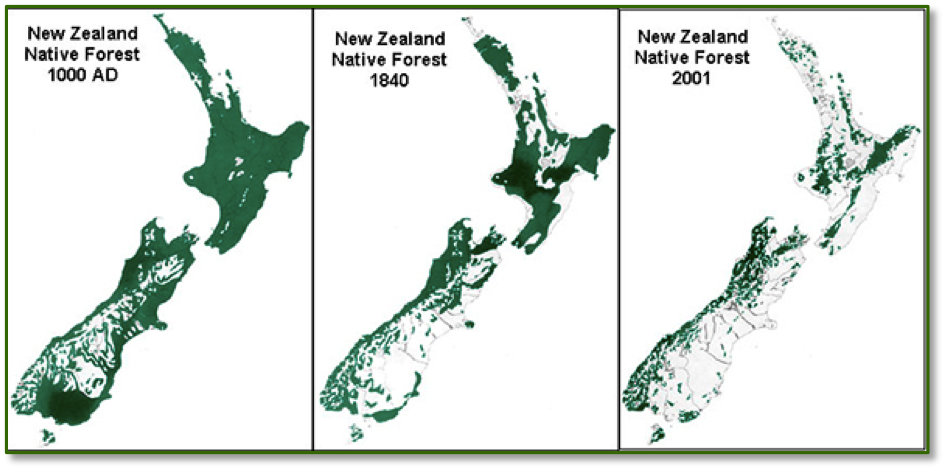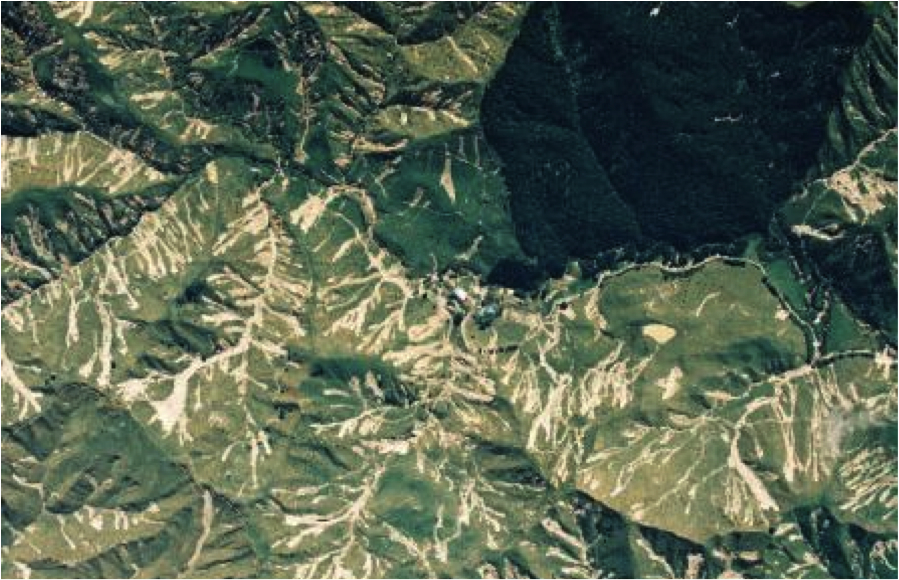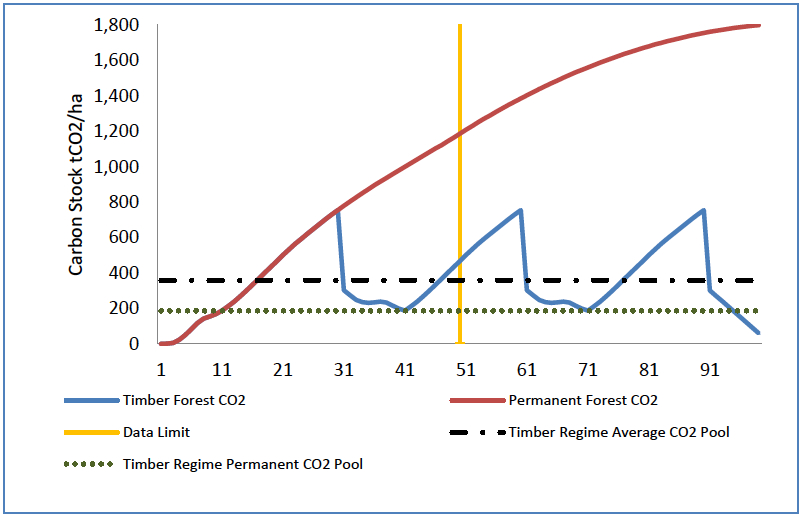The Importance of reforestation mechanisms
The world is struggling in the fight against climate change. Efforts to maintain, let alone improve, a Kyoto type agreement are faltering while greenhouse gas (GHG) levels continue to rise along the worst case business as usual scenario.
Recognition of the importance of reducing emissions from destruction of forests has been belatedly recognised with REDD plus initiatives. However the crucial importance of reforestation, and improved forest management to rapidly sequester and store carbon whilst delivering other ecological co benefits is still largely overlooked.
Growing more forests provides the only readily available means to suck CO2 out of the atmosphere, and to restore the inevitable overshoot of GHGs to safer levels well below 450ppm (99% of other climate change efforts are focused on avoiding emissions not removing existing atmospheric CO2.)
New Zealand (NZ) was the first country to develop and implement carbon forestry under a government regulated framework and now has developed two such mechanisms; one called NZ ETS forestry is designed to be compatible with short rotation timber plantations; while the Permanent Forest Sink Initiative (PFSI) is designed as a ‘best practice’, dedicated long term carbon conservation scheme.
This article is about the PFSI, its origins, purposes and attributes as a scheme for dedicated carbon forestry which may well provide a useful model for other jurisdictions.
What is the NZ Permanent Forest Sink Initiative?
The PFSI is a Kyoto compliant carbon forestry scheme designed by the NZ government to encourage reforestation of marginal farm land by private landowners. It is also the world’s first Kyoto compliant Annex 1 country carbon and conservation forestry scheme.
The PFSI rewards participants by assigning to them all sequestered carbon (whilst holding them to account for maintaining the stored carbon) and enabling the carbon to be traded in Kyoto compliant markets.
In return for earning carbon credits landowners undertake stringent obligations to develop and maintain a permanent carbon forest on their land in perpetuity.
Origins of the PFSI
The invention of the PFSI arose from NZ’s ecological problems on the one hand, and its uniquely high agriculture sector emissions profile and LULUCF requirements on the other.
When the first humans settled New Zealand just 800 years ago 80 percent of the land was covered in pristine rainforest. Human settlement unleashed major forest destruction and species extinctions. Fires during the Polynesian settlement period erased a third of the forest cover, and half of the remaining forest was destroyed by 19th century European settlers. Today remnants of forest are mainly restricted to high rainfall mountains, and are everywhere degraded due to depredations of introduced animal pests such as deer, goats and possums.

Indigenous Forest Cover loss in NZ following human settlement, 1000 AD-2001.
The destruction of forests by the first waves of Maori and European settlers released some 15 billion tonnes of CO2 into the atmosphere, perhaps the highest per capita releases of CO2 in human history.
Today NZ’s economy (c. 4.5 million people) is largely dependent on agriculture and commercial timber plantations located on these former forestlands, and on tourism. A third of NZ - about 9 million hecatares (ha)) is owned and managed by the Crown as conservation estate and includes almost all remaining indigenous forest. Across the productive land bank about 100 million livestock units are farmed on 14 million ha of pasture, and close to 1.8 million ha of plantations are managed for timber production.
Unsustainable Land Use and Environmental Damage
NZ is a very young country in geological as well as human terms. Much of the landscape has been uplifted by seismic and volcanic activity over the last few million years. Related to productive land uses NZ has three acute environmental challenges: extremely high erosion rates on steep farmlands (topsoil loss >20t/ha/annum on 700,000ha), faecal and nutrient pollution of streams and lakes in drainages of farmed areas, and loss of indigenous habitat, flora and fauna.

Photo; Soil erosion scars on steep hill country farmland following a high rainfall storm event. NZ has c. 1.2 million hectares of steep hill country pasture that is at risk to extreme erosion. Forests are highly effective in protecting against topsoil erosion (Top right forest area has very little soil loss)
NZ landowners work their land without any subsidies - in other words there has been no economic alternative to continuation of farming or conversion to short rotation timber forestry. Recovery of conservation forest cover onto these problematic lands could effectively solve all of these ecological problems, but an economic driver is required for this to happen.
Kyoto Protocol marginalised forestry
In 2002 NZ Government policy advisors conceived the PFSI as a NZ domestic policy initiative to encourage afforestation of marginal farmland by assigning tradable Kyoto carbon offset credits and liabilities to participating landowners.
The design had to be Kyoto compliant in terms of the definition of forests and forest rules. But equally importantly the people designing the PFSI knew that to generate carbon credits that would have value in the international carbon market, a number of key concerns about forestry needed to be addressed within the PFSI design.
In particular carbon forests had a negative reputation because of concerns about
- permanence (i.e. forest removals are reversed by harvesting or fire)
- additionality (i.e. forests can be business as usual timber plantations)
- verification and monitoring of carbon stocks
- compliance (i.e. enforcing protection and on-going storage of carbon)
The PFSI was designed to meet these concerns.
Key Design Features:
The main feature of the PFSI is the restrictions on harvesting and the permanence obligations. Originally the PFSI was conceived as a no harvest regime for at least 99 years. Following consultation, provision was made for low intensity sustainable timber harvesting during the 99 year minimum period the participating forest is required to be maintained, subject to replacement liabilities on any lost carbon. Provision was also made to allow participants to withdraw after 50 years, subject to full replacement of carbon stocks. In reality it is most unlikely any participants would clear their forests after 50 or 100 years because of the prohibitive cost of carbon replacement.
As a result of being maintained for the long term, PFSI forests will sequester and secure high carbon densities. By comparison, sequestration by short rotation bioenergy plantations and industrial timber plantations might be as little as 10% to 30% of long-lived forests.

Figure 1 represents carbon stocks (t C02/ha) of planted radiata pine forest in NZ from time of planting to 100 years age, The timber regime is clear-felled every 30 years releasing stored carbon. Data on which the modelling is based is statistically ‘rich’ from 0-50 years and ‘poor’ from 50-100 years.
- The Crown (NZ Government) is guarantor of the scheme and of the issued credits.
- Each PFSI project is based on a contractual agreement between the Crown and the landowner, registered as a Covenant on the land title.
- The Crown issues carbon credits for increased carbon stocks within the forest and the landowner will maintain a forest on the land for a minimum of 99 years.
- There are strict prohibitions against clear fell harvesting for the 99 year period although some limited sustainable harvesting on a “continuous canopy basis” is permissible.
- The landowner is responsible for any carbon lost from the forest for the duration of the agreement. In other words if there is harvesting (within the rules) or a natural event such as fire or wind-throw, then the forest owner must repay to the Crown the lost carbon.
- The Crown has extensive powers to ensure the PFSI is complied with. This includes entering the land and establishing a forest where the landowner has failed to maintain one.
- Registration is a straight forward and low cost process. Preparation of an application with high resolution mapping and registration fees may take less than 4 months to complete and cost less than USD $1500 per project.
- On-going (5 yearly) carbon measurement is required for projects >100 ha and the cost is typically in the range of USD $4-5 per hectare per annum.
- The Government maintains a carbon registry for each project under the NZ Emissions Unit Registry that records the assignment of carbon stocks.
- Insurance offerings to cover against loss of carbon have been developed by several providers. Cost of fire and wind insurance offerings for full replacement value of carbon are available for <USD $15/ha/an
Progress of the PFSI
In late 2006 the empowering PFSI legislation was passed unanimously by NZ Parliament, a rare achievement in NZ’s multiparty politics. A year later when key PFSI regulations and the Government PFSI Covenant agreement were completed the registration of the first PFSI forest carbon conservation projects got underway.
Since the scheme began in 2007 about 55 projects (c.14, 000 ha) have been registered with another 10 (c. 5000ha) in the pipeline. The projects comprise both indigenous forest recovery projects (70%) and planted forests (30%).
The Government undertook a public consultation and review of the PFSI in 2011 and not surprisingly the majority of submissions were supportive, although ETS plantation forestry sector submissions were not. There is strong support for the PFSI from leading environmental NGOs, including Greenpeace, WWF, and Forest and Bird (NZ’s largest environmental NGO), and strong cross-party political support continues.
It needs to be remembered that Landowners who register under the PFSI are making a major commitment; to maintain and protect their forest areas as permanent carbon conservation sinks while shouldering replacement liabilities and forgoing other commercial options such as clearing the land for farming or commercial timber plantations.
Uptake of the PFSI will be determined by whether carbon offsetting proves to be a viable commercial alternative to more conventional landuse options, and this rests on support provided through purchase of PFSI offsets. Participants need to know with some surety that carbon sequestered in their forests will be saleable into the future at an attractive price. The greater this surety the greater the uptake will be.
If the most ecologically problematic land types amounting to ten percent of NZ’s farmland were afforested for carbon and conservation over the next few decades the resulting sequestration could exceed 2GtCO2 within 50 years, and could serve to offset the entirety of the agriculture sectors intractable emissions over this period.
The extent to which this might be achieved will depend on the market value of PFSI carbon units. If there is sufficient payment for the environmental services that PFSI conservation forests provide there is a major opportunity for the environmental damage resulting from human settlement in NZ to be healed.
The author is Managing Director of Permanent Forests International Ltd (not to be confused with the Permanent Forest Sink Initiative (PFSI)), a NZ based company that specialises in best practice carbon forestry. www.permanentforests.com
- Log in to post comments
